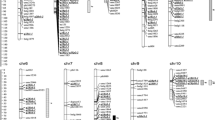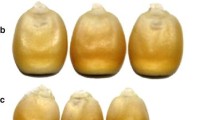Abstract
All crop species have been domesticated from their wild relatives, and geneticists are just now beginning to understand the consequences of artificial (human) selection on agronomic traits that are relevant today. The primary consequence is a basal loss of diversity across the genome, and an additional reduction in diversity for genes underlying traits targeted by selection. An understanding of attributes of the wild relatives may provide insight into target traits and valuable allelic variants for modern agriculture. This is especially true for maize (Zea mays ssp. mays), where its wild ancestor, teosinte (Z. mays ssp. parviglumis), is so strikingly different than modern maize. One obvious target of selection is the size and composition of the kernel. We evaluated kernel characteristics, kernel composition, and zein profiles for a diverse set of modern inbred lines, teosinte accessions, and landraces, the intermediate between inbreds and teosinte. We found that teosinte has very small seeds, but twice the protein content of landraces and inbred lines. Teosinte has a higher average alpha zein content (nearly 89% of total zeins as compared to 72% for inbred lines and 76% for landraces), and there are many novel alcohol-soluble proteins in teosinte relative to the other two germplasm groups. Nearly every zein protein varied in abundance among the germplasm groups, especially the methionine-rich delta zein protein, and the gamma zeins. Teosinte and landraces harbor phenotypic variation that will facilitate genetic dissection of kernel traits and grain quality, ultimately leading to improvement via traditional plant breeding and/or genetic engineering.





Similar content being viewed by others
References
AOAC (2006) Official methods of analysis of AOAC INTERNATIONAL, 18th edn. AOAC INTERNATIONAL, Gaithersburg
Bjarnason M, Pollmer WG (1972) The maize germ: its role as a contributing factor to protein quantity and quality. Z Pflanzenzuchtg 68:83–89
Briggs WH, McMullen MD, Gaut BS, Doebley J (2007) Linkage mapping of domestication loci in a large maize teosinte backcross resource. Genetics 177:1915–1928
Bulant C, Gallais A (1998) Xenia effects in maize with normal endosperm: I. Importance and stability. Crop Sci 38:1517–1525
Bulant C, Gallais A, Matthys-Rochon E, Prioul JL (2000) Xenia effects in maize with normal endosperm: II. Kernel growth and enzyme activities during grain filling. Crop Sci 40:182–189
Clark R, Linton E, Messing J, Doebley J (2004) Pattern of diversity in the genomic region near the maize domestication gene tb1. Proc Natl Acad Sci USA 101:700–707
Coleman CE, Herman EM, Takasaki K, Larkins BA (1996) The maize gamma-zein sequesters alpha-zein and stabilizes its accumulation in protein bodies of transgenic tobacco endosperm. Plant Cell 8:2335–2345
Curtis JJ, Brunson AM, Hubbard JE, Earle FR (1956) Effect of the pollen parent on oil content of the corn kernel. Agron J 48:551–555
Doebley J (2004) The genetics of maize evolution. Annu Rev Genet 38:37–59
Doebley J, Stec A, Gustus C (1995) Teosinte branched1 and the origin of maize: evidence for epistasis and the evolution of dominance. Genetics 141:333–346
Dorweiler J, Stec A, Kermicle J, Doebley J (1993) Teosinte glume architecture 1: a genetic locus controlling a key step in maize evolution. Science 262:233–235
Ducrocq S, Madur D, Veyrieras J-B, Camus-Kulandaivelu L, Kloiber-Maitz M, Presterl T, Ouzunova M, Manicacci D, Charcosset A (2008) Key impact of Vgt1 on flowering time adaptation in maize: evidence from association mapping and ecogeographical information. Genetics 178:2433–2437
Dudley JW (2007) From means to QTL: the Illinois long-term selection experiment as a case study in quantitative genetics. Crop Sci 47:S20–S31
Focke WO (1881) Die Pflanzen-Mischlinge. Ein Beitrag zur Biologie der Gewächse
Hamblin MT, Casa AM, Sun H, Murray SC, Paterson AH, Aquadro CF, Kresovich S (2006) Challenges of detecting directional selection after a bottleneck: lessons from Sorghum bicolor. Science 173:953–964
Hopkins CG (1899) Improvement in the chemical composition of the corn kernel. Ill Agric Expt Sta Bul 55:205–240
Huang S, Adams WR, Zhou Q, Malloy KP, Voyles DA, Anthony J, Kriz AL, Luethy MH (2004) Improving nutritional quality of maize proteins by expressing sense and antisense zein genes. J Agric Food Chem 52:1958–1964
Huang S, Kruger DE, Frizzi A, D’Ordine RL, Florida CA, Adams WR, Brown WE, Luethy MH (2005) High-lysine corn produced by the combination of enhanced lysine biosynthesis and reduced zein accumulation. Plant Biotechnol J 3:555–569
Hyten DL, Song Q, Zhu Y, Choi I-Y, Nelson RL, Costa JM, Specht JE, Shoemaker RC, Cregan PB (2006) Impacts of genetic bottlenecks on soybean genome diversity. Proc Natl Acad Sci USA 103:16666–16671
Kaiser HF (1960) The application of electronic computers to factor analysis. Educ Psychol Meas 20:141–151
Lai J, Messing J (2002) Increasing maize seed methionine by mRNA stability. Plant J 30:395–402
Matsuoka Y, Vigouroux Y, Goodman MM, Sanchez GJ, Buckler E, Doebley J (2002) A single domestication for maize shown by multilocus microsatellite genotyping. Proc Natl Acad Sci USA 99:6080–6084
McMullen MM, Kresovich S, Buckler ES, Holland JB, Sanchez Villeda H, Bradbury P, Li H, Sun Q, Bottoms C, Flint-Garcia S, Hanson M, Acharya C, Yates H, Mitchell SE, Browne C, Eller M, Guill K, Kroon D, Lepak N, Romero S, Salvo S, Peterson B, Jones E, Smith S, Brown P, Pressoir G, Oropeza Rosas M, Harjes C, Glaubitz JC, Goodman M, Ware D (2009) Genetic properties of the maize nested association mapping population (accepted)
Melcher U, Fraij B (1980) Methionine-rich protein fraction prepared by cryoprecipitation from extracts of corn meal. J Agric Food Chem 28:1334–1336
Paulis JW, Wall JS (1977) Comparison of the protein compositions of selected corns and their wild relatives, teosinte and Tripsacum. J Agric Food Chem 25:265–270
Phillips RL, Suresh J, Olsen M, Krone T (2008) Registration of high-methionine versions of maize inbreds A632, B73, and Mo17. J Plant Regist 2:243–245
Pollak LM (2003) The history and success of the public-private project on germplasm enhancement of maize (GEM). Adv Agron 78:45–87
Pollmer WG, Eberhard D, Klein D (1978) Inheritance of protein and yield of grain and stover in maize. Crop Sci 18:757–759
Prasanna BM, Vasal SK, Kassahun B, SN N (2001) Quality protein maize. Curr Sci 81:1308–1319
Rossi V, Hartings H, Thompson RD, Motto M (2001) Genetic and molecular approaches for upgrading starch and protein fractions in maize kernels. Maydica 46:147–158
SAS Institute Inc. (1999–2001) SAS® Proprietary Software Release 8.2, Cary
Sodek L, Wilson CM (1971) Amino acid compositions of proteins isolated from normal, opaque-2, and floury-2 corn endosperms by a modified Osborne procedure. J Agric Food Chem 19:1144–1150
Song R, Messing J (2002) Contiguous genomic DNA sequence comprising the 19-kDa zein gene family from maize. Plant Physiol 130:1626–1635
Song R, Messing J (2003) Gene expression of a gene family in maize based on noncollinear haplotypes. Proc Natl Acad Sci USA 100:9055–9060
Song R, Llaca V, Linton E, Messing J (2001) Sequence, regulation, and evolution of the maize 22-kDa alpha zein gene family. Genome Res 11:1817–1825
Swarup S, Timmermans MC, Chaudhuri S, Messing J (1995) Determinants of the high-methionine trait in wild and exotic germplasm may have escaped selection during early cultivation of maize. Plant J 8:359–368
Tang T, Lu J, Huang J, He J, McCouch SR, Shen Y, Kai Z, Purugganan MD, Shi S, Wu C-I (2006) Genomic variation in rice: genesis of highly polymorphic linkage blocks during domestication. PLoS Genet 2:e199
Thompson GA, Larkins BA (1989) Structural elements regulating zein gene expression. BioEssays 10:108–113
Thompson GA, Siemieniak DR, Sieu LC, Slightom JL, Larkins BA (1992) Sequence analysis of linked maize 22 kDa alpha-zein genes. Plant Mol Biol 18:827–833
Vasal SK (2000) High quality protein corn. In: Hallauer AR (ed) Specialty corns, 2nd edn. CRC Press, Boca Raton
Wang RL, Stec A, Hey J, Lukens L, Doebley J (1999) The limits of selection during maize domestication. Nature 398:236–239
Wang L, Xu C, Qu M, Zhang J (2008) Kernel amino acid composition and protein content of introgression lines from Zea mays ssp. mexicana into cultivated maize. J Cereal Sci 48:387–393
Watson SA (2003) Description, development, structure, and composition of the corn kernel. In: White PJ, Johnson LA (eds) Corn: chemistry and technology, 2nd edn. American Association of Cereal Chemists, St. Paul
Webber HJ (1900) Xenia, or the immediate effect of pollen, in maize. USDA Bull 22:1–44
Whitt SR, Wilson LM, Tenaillon MI, Gaut BS, Buckler ES (2002) Genetic diversity and selection in the maize starch pathway. Proc Natl Acad Sci USA 20:12959–12962
Wilson C (1991) Multiple zeins from maize endosperms characterized by reversed-phase high performance liquid chromatography. Plant Physiol 95:777–786
Wilson DR, Larkins BA (1984) Zein gene organization in maize and related grasses. J Mol Evol 20:330–340
Woo Y-M, Hu DW-N, Larkins BA, Jung R (2001) Genomics analysis of genes expressed in maize endosperm identifies novel seed proteins and clarifies patterns of zein gene expression. Plant Cell 13:2297–2317
Wright SI, Vroh Bi I, Schroeder SG, Yamasaki M, Doebley JF, McMullen MD, Gaut BS (2005) The effects of artificial selection on the maize genome. Science 308:1310–1314
Xiao J, Li J, Grandillo S, Ahn SN, Yuan L, Tanksley SD, McCouch SR (1998) Identification of trait-improving quantitative trait loci alleles from a wild rice relative, Oryza rufipogon. Genetics 150:899–909
Buckler ES, Holland JB, Bradbury P, Acharya C, Brown P, Browne C, Ersoz E, Flint-Garcia S, Garcia A, Glaubitz JC, Goodman M, Harjes C, Guill K, Kroon D, Larsson S, Lepak N, Li H, Mitchell SE, Pressoir G, Peiffer J, Oropeza Rosas M, Rocheford T, Romay C, Romero S, Salvo S, Sanchez Villeda H, Sun Q, Tian F, Upadyayula N, Ware D, Yates H, Yu J, Zhang Z, Kresovich S, McMullen MM The genetic architecture of Maize flowering time (submitted)
Yamasaki M, Tenaillon MI, Vroh Bi I, Schroeder SG, Sanchez-Villeda H, Doebley JF, Gaut BS, McMullen MD (2005) A large-scale screen for artificial selection in maize identifies candidate agronomic loci for domestication and crop improvement. Plant Cell 17:2859–2872
Yu J, Arbelbide M, Bernardo R (2005) Power of in silico QTL mapping from phenotypic, pedigree, and marker data in a hybrid breeding program. Theor Appl Genet 110:1061–1067
Yu J, Holland JB, McMullen MD, Buckler ES (2008) Genetic design and statistical power of nested association mapping in maize. Genetics 178:539–551
Acknowledgments
We would like to thank Susan Melia-Hancock (USDA-ARS in Columbia, MO) for collecting data regarding seed weight and embryo-endosperm ratio; these are especially challenging traits to evaluate in teosinte. We would also like to thank Hari Krishnan (USDA-ARS in Columbia, MO) for conducting preliminary experiments leading to this larger study, and Adrienne Moran Lauter (USDA-ARS in Ames, IA) for technical assistance. This research was supported by a National Science Foundation Plant Genome Award (DBI0321467), the USDA-CSREES special appropriation “Plant Biotechnology Iowa,” and by research funds provided by USDA-ARS. Names of products are necessary to report factually on available data; however, neither the USDA nor any other participating institution guarantees or warrants the standard of the product, and the use of the name does not imply approval of the product to the exclusion of others that may also be suitable.
Author information
Authors and Affiliations
Corresponding author
Additional information
Communicated by A. Bervillé.
Electronic supplementary material
Below is the link to the electronic supplementary material.
122_2009_1115_MOESM2_ESM.jpg
Supplemental Fig. 2. Detailed view of the alpha zein region. Arrows indicate prominent peaks that are conserved in the inbred and landrace groups (JPEG 268 kb)
Rights and permissions
About this article
Cite this article
Flint-Garcia, S.A., Bodnar, A.L. & Scott, M.P. Wide variability in kernel composition, seed characteristics, and zein profiles among diverse maize inbreds, landraces, and teosinte. Theor Appl Genet 119, 1129–1142 (2009). https://doi.org/10.1007/s00122-009-1115-1
Received:
Accepted:
Published:
Issue Date:
DOI: https://doi.org/10.1007/s00122-009-1115-1




